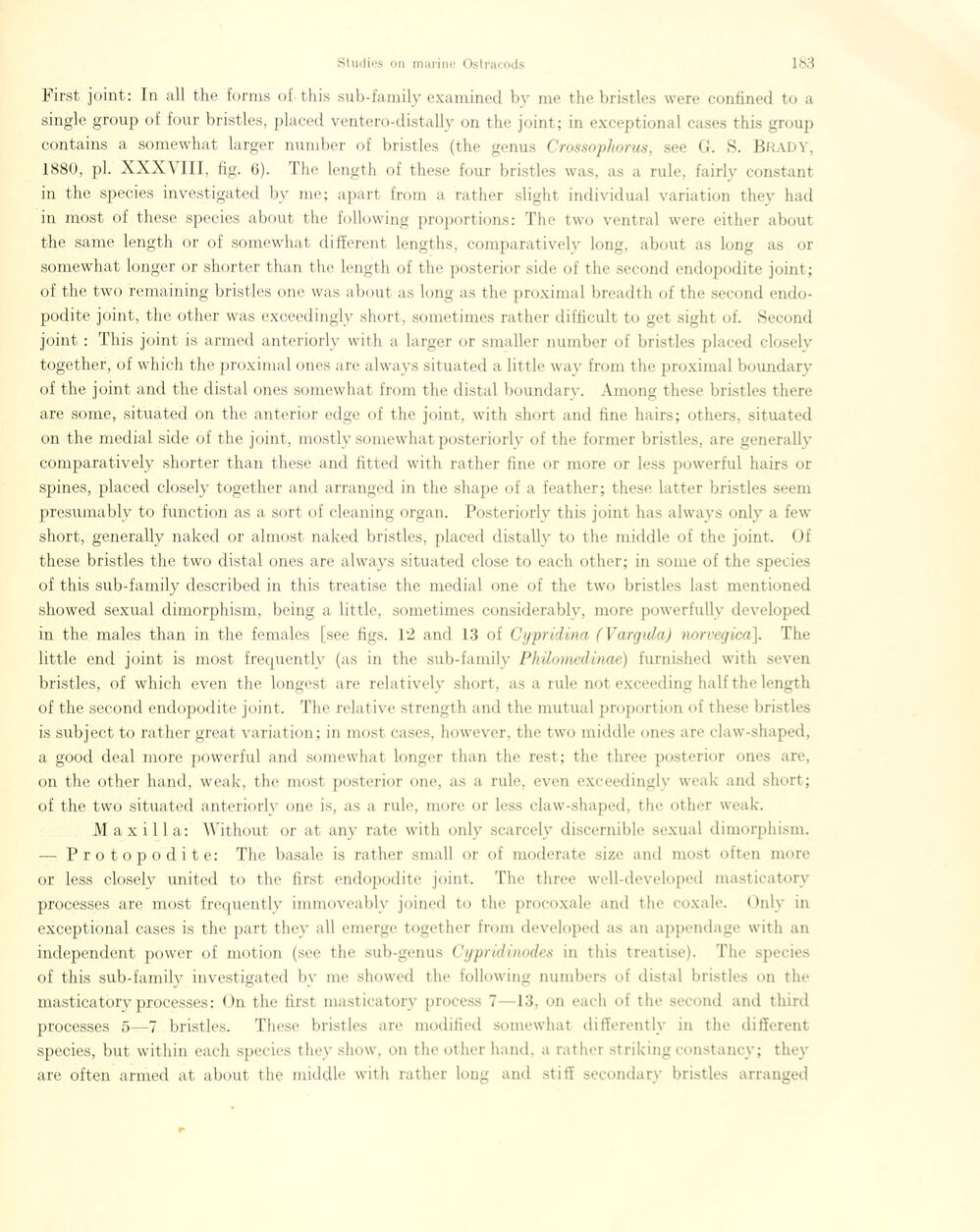
Full resolution (JPEG) - On this page / på denna sida - Sidor ...

<< prev. page << föreg. sida << >> nästa sida >> next page >>
Below is the raw OCR text
from the above scanned image.
Do you see an error? Proofread the page now!
Här nedan syns maskintolkade texten från faksimilbilden ovan.
Ser du något fel? Korrekturläs sidan nu!
This page has never been proofread. / Denna sida har aldrig korrekturlästs.
First joint: In all the forms ol this sub-family examined bv me the bristles were confined to a
single group of four bristles, placed ventero-distally on the joint; in exceptional cases this group
contains a somewhat larger number of bristles (the genus Crossophorus, see G. S. BRADY,
1880, pl. XXXA III, fig. 6). The length of these four bristles was, as a ride, fairly constant
in the species investigated by me; apart from a rather slight individual variation thev had
in most of these species about the following proportions: The tvvo ventral were either about
the same length or of somewhat different lengths, comparativelv long, about as long as or
somewhat longer or shorter than the length of the posterior side of the second endopodite joint;
of the two remaining bristles onc was about as long as the proximal breadth of the second
endopodite joint, the other was exceedingly short, sometimes rather difficult to get sight of. Second
joint : This joint is armed anteriorly with a larger or smaller number of bristles placed closelv
together, of which the proximal ones are always situated a little way from the proximal boundary
of the joint and the distal ones somewhat from the distal boundary. Among these bristles there
are some, situated on the anterior edge of the joint, with short and fine hairs; otliers, situated
on the medial side of the joint, mostly somewhat posteriorly of the former bristles, are generally
comparatively shorter than these and fitted with rather fine or more or less powerful hairs or
spines, placed closely together and arranged in the shape of a feather; these latter bristles seem
presumably to function as a sort of cleaning organ. Posteriorly this joint has always only a few
short, generally naked or almost naked bristles, placed distally to the middle of the joint. Of
these bristles the two distal ones are always situated close to each other; in sonie of the species
of this sub-family described in this treatise the medial one of the two bristles last mentioned
showed sexual dimorphism, being a little, sometimes considerably, more powerfully developed
in the males than in the females [see figs. 12 and 13 of Gypridina (Vargula) norvegica]. The
little end joint is most frequentlv (as in the sub-family Phüomedinae) furnished with seven
bristles, of which even the longest are relatively short, as a rule not exceeding half the length
of the second endopodite joint. The relative strength and the mutual proport ion of these bristles
is subject to rather great variation; in most cases, however, the two middle ones are claw-shapecl,
a good deal more powerful and somewhat longer than the rest; the three posterior ones are,
on the other hånd, weak, the most posterior one, as a rule, even exceedingly weak and short;
of the two situated anteriorly one is, as a rule, more or less claw-shaped, the other weak.
Maxilla: Without or at any rate with only scarcelv discernible sexual dimorphism.
— Protopo dite: The basale is rather small or of moderate size and most often more
or less closely united to the first endopodite joint. The three well-developed masticatory
processes are most frequently immoveably joined to the procoxale and the coxale. Only in
exceptional cases is the part they all emerge together from developed as an appendage with an
independent power of motion (see the sub-genus Cypridinodes in this treatise). The species
of this sub-family investigated by me showed the following numbers of distal bristles on the
masticatory processes: On the first masticatory process 7—13, on each of the second and third
processes 5—7 bristles. These bristles are modified somewhat differently in the different
species, but within eacli species they show, on the other hand, a rather strikingconstancy; they
are often armed at about the middle with rather long and sti ff secondary bristles arranged
<< prev. page << föreg. sida << >> nästa sida >> next page >>